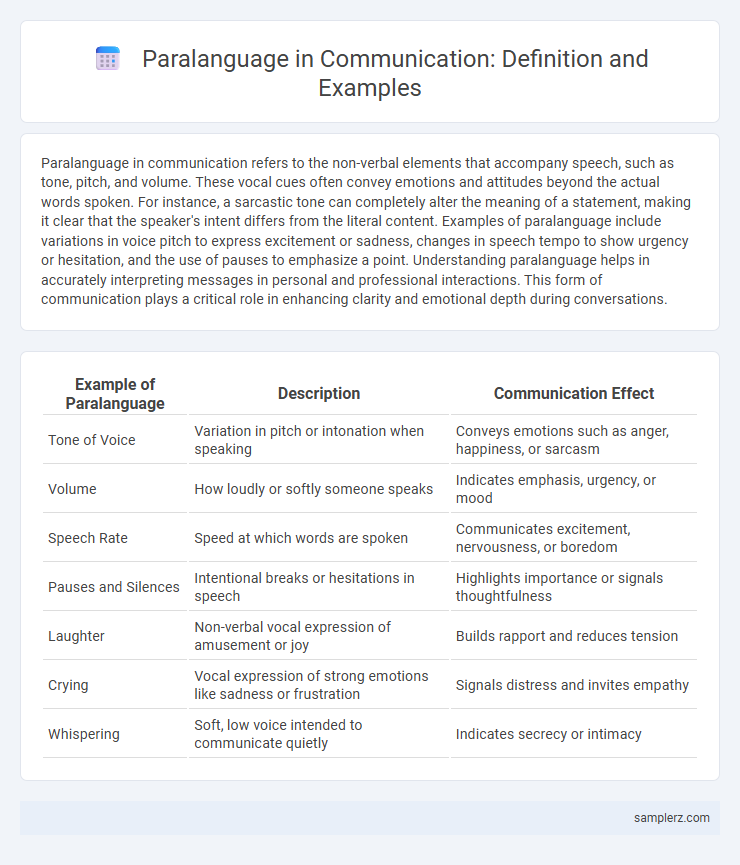Paralanguage in communication refers to the non-verbal elements that accompany speech, such as tone, pitch, and volume. These vocal cues often convey emotions and attitudes beyond the actual words spoken. For instance, a sarcastic tone can completely alter the meaning of a statement, making it clear that the speaker's intent differs from the literal content. Examples of paralanguage include variations in voice pitch to express excitement or sadness, changes in speech tempo to show urgency or hesitation, and the use of pauses to emphasize a point. Understanding paralanguage helps in accurately interpreting messages in personal and professional interactions. This form of communication plays a critical role in enhancing clarity and emotional depth during conversations.
Table of Comparison
| Example of Paralanguage | Description | Communication Effect |
|---|---|---|
| Tone of Voice | Variation in pitch or intonation when speaking | Conveys emotions such as anger, happiness, or sarcasm |
| Volume | How loudly or softly someone speaks | Indicates emphasis, urgency, or mood |
| Speech Rate | Speed at which words are spoken | Communicates excitement, nervousness, or boredom |
| Pauses and Silences | Intentional breaks or hesitations in speech | Highlights importance or signals thoughtfulness |
| Laughter | Non-verbal vocal expression of amusement or joy | Builds rapport and reduces tension |
| Crying | Vocal expression of strong emotions like sadness or frustration | Signals distress and invites empathy |
| Whispering | Soft, low voice intended to communicate quietly | Indicates secrecy or intimacy |
Understanding Paralanguage: Definition and Importance
Paralanguage in communication refers to the non-verbal elements that accompany speech, such as tone, pitch, volume, and speech rate, which convey meaning beyond words. Understanding paralanguage is crucial because it helps interpret emotions, intentions, and attitudes, enhancing overall message comprehension. For example, a raised voice can signal anger or urgency, while a soft tone may indicate calmness or sympathy, demonstrating how paralanguage influences interpersonal communication effectiveness.
Vocal Tone and Its Impact in Communication
Vocal tone in communication significantly influences how messages are perceived, conveying emotions such as anger, sarcasm, or sincerity beyond the spoken words. Variations in pitch, volume, and speed serve as key paralanguage elements that shape listeners' interpretations and emotional responses. Effective use of vocal tone enhances clarity, builds rapport, and facilitates more meaningful interactions in both personal and professional contexts.
Variations in Pitch as Paralanguage
Variations in pitch serve as a key element of paralanguage, significantly influencing the emotional tone and clarity of verbal communication. Higher pitch often conveys excitement or urgency, while lower pitch can indicate seriousness or calmness, affecting how messages are perceived. Understanding these pitch variations enhances effective communication by providing non-verbal cues that complement spoken words.
The Role of Volume in Conveying Meaning
Volume in paralanguage plays a crucial role in communication by emphasizing emotions and intentions beyond spoken words. A loud volume can indicate anger or excitement, while a soft volume may express intimacy or hesitation. Variations in volume help listeners interpret the speaker's true feelings and the context of the message.
Speech Rate: Fast vs. Slow in Effective Messaging
Speech rate significantly impacts message clarity and audience engagement in communication. Speaking fast can convey urgency and excitement but may hinder comprehension, while a slower pace enhances understanding and allows for emphasis on key points. Effective communicators adjust their speech rate to match the context, audience, and desired emotional tone to optimize message delivery.
Strategic Use of Pauses in Conversation
Strategic use of pauses in conversation serves as a powerful paralanguage tool to emphasize key points and manage conversational flow. Pausing intentionally can convey confidence, create suspense, and allow listeners time to process information, enhancing message clarity. Research indicates that well-timed pauses improve engagement and promote more thoughtful responses in communication.
Emotional Expression through Laughter and Sighs
Paralanguage significantly enhances emotional expression in communication through laughter and sighs, conveying feelings often beyond words. Laughter can signal joy, sarcasm, or nervousness, while sighs express relief, frustration, or exhaustion, enriching interpersonal understanding. These vocal cues provide crucial context, enabling listeners to interpret underlying emotions accurately.
Influence of Accent and Pronunciation on Perception
Accent and pronunciation significantly shape listener perception by conveying information about a speaker's regional background, social identity, and credibility. Variations in intonation, stress, or speech rhythm can influence judgments about a speaker's friendliness, intelligence, and trustworthiness, impacting effective communication. Research shows that accents perceived as unfamiliar or stigmatized often lead to bias, highlighting the crucial role of paralanguage in communication dynamics.
Nonverbal Vocalizations: Grunts, Gasps, and Umm’s
Nonverbal vocalizations such as grunts, gasps, and umm's play a crucial role in communication by conveying emotions and regulating conversation flow without words. Grunts often signal agreement or hesitation, while gasps express surprise or disbelief, and umm's indicate pauses or uncertainty during speech. Understanding these paralanguage cues enhances interpretation of speakers' true intentions and emotional states in verbal interactions.
Cultural Differences in Paralanguage Usage
Paralanguage in communication varies significantly across cultures, such as the use of intonation patterns, pitch, and vocal stress that convey different meanings. For instance, a high pitch may indicate excitement in Western cultures, while in some East Asian cultures, it might be perceived as a sign of nervousness or lack of confidence. Understanding these cultural differences in paralanguage helps avoid misinterpretations and enhances effective cross-cultural communication.

example of paralanguage in communication Infographic
 samplerz.com
samplerz.com